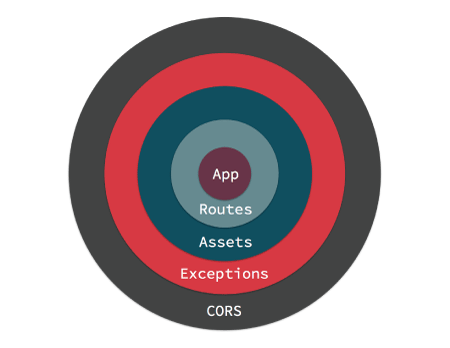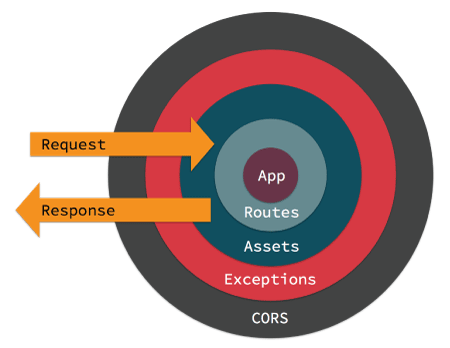This document is for CakePHP's development version, which can be significantly different
from previous releases.
You may want to read
current stable release documentation instead.
Middleware¶
Middleware objects give you the ability to ‘wrap’ your application in re-usable, composable layers of Request handling, or response building logic. Visually, your application ends up at the center, and middleware is wrapped around the app like an onion. Here we can see an application wrapped with Routes, Assets, Exception Handling and CORS header middleware.

When a request is handled by your application it enters from the outermost middleware. Each middleware can either delegate the request/response to the next layer, or return a response. Returning a response prevents lower layers from ever seeing the request. An example of that is the AssetMiddleware handling a request for a plugin image during development.

If no middleware take action to handle the request, a controller will be located and have its action invoked, or an exception will be raised generating an error page.
Middleware are part of the new HTTP stack in CakePHP that leverages the PSR-7 request and response interfaces. CakePHP also supports the PSR-15 standard for server request handlers so you can use any PSR-15 compatible middleware available on The Packagist.
Middleware in CakePHP¶
CakePHP provides several middleware to handle common tasks in web applications:
Cake\Error\Middleware\ErrorHandlerMiddlewaretraps exceptions from the wrapped middleware and renders an error page using the Error & Exception Handling Exception handler.Cake\Routing\AssetMiddlewarechecks whether the request is referring to a theme or plugin asset file, such as a CSS, JavaScript or image file stored in either a plugin’s webroot folder or the corresponding one for a Theme.Cake\Routing\Middleware\RoutingMiddlewareuses theRouterto parse the incoming URL and assign routing parameters to the request.Cake\I18n\Middleware\LocaleSelectorMiddlewareenables automatic language switching from theAccept-Languageheader sent by the browser.Cake\Http\Middleware\EncryptedCookieMiddlewaregives you the ability to manipulate encrypted cookies in case you need to manipulate cookie with obfuscated data.Cake\Http\Middleware\BodyParserMiddlewareallows you to decode JSON, XML and other encoded request bodies based onContent-Typeheader.CakeHttpMiddlewareHttpsEnforcerMiddleware requires HTTPS to be used.
CakeHttpMiddlewareCsrfProtectionMiddleware adds double-submit cookie based CSRF protection to your application.
CakeHttpMiddlewareSessionCsrfProtectionMiddleware adds session based CSRF protection to your application.
CakeHttpMiddlewareCspMiddleware makes it simpler to add Content-Security-Policy headers to your application.
CakeHttpMiddlewareSecurityHeadersMiddleware makes it possible to add security related headers like
X-Frame-Optionsto responses.CakeHttpMiddlewareRateLimitMiddleware provides configurable rate limiting to protect against abuse and ensure fair usage of resources.
Using Middleware¶
Middleware can be applied to your application globally, to individual routing scopes, or to specific controllers.
To apply middleware to all requests, use the middleware method of your
App\Application class. Your application’s middleware hook method will be
called at the beginning of the request process, you can use the
MiddlewareQueue object to attach middleware:
namespace App;
use Cake\Core\Configure;
use Cake\Error\Middleware\ErrorHandlerMiddleware;
use Cake\Http\BaseApplication;
use Cake\Http\MiddlewareQueue;
class Application extends BaseApplication
{
public function middleware(MiddlewareQueue $middlewareQueue): MiddlewareQueue
{
// Bind the error handler into the middleware queue.
$middlewareQueue->add(new ErrorHandlerMiddleware(Configure::read('Error'), $this));
// Add middleware by classname.
// As of 4.5.0 classname middleware are optionally resolved
// using the DI container. If the class is not found in the
// container then an instance is created by the middleware queue.
$middlewareQueue->add(UserRateLimiting::class);
return $middlewareQueue;
}
}
In addition to adding to the end of the MiddlewareQueue you can do
a variety of operations:
$layer = new \App\Middleware\CustomMiddleware;
// Added middleware will be last in line.
$middlewareQueue->add($layer);
// Prepended middleware will be first in line.
$middlewareQueue->prepend($layer);
// Insert in a specific slot. If the slot is out of
// bounds, it will be added to the end.
$middlewareQueue->insertAt(2, $layer);
// Insert before another middleware.
// If the named class cannot be found,
// an exception will be raised.
$middlewareQueue->insertBefore(
'Cake\Error\Middleware\ErrorHandlerMiddleware',
$layer
);
// Insert after another middleware.
// If the named class cannot be found, the
// middleware will added to the end.
$middlewareQueue->insertAfter(
'Cake\Error\Middleware\ErrorHandlerMiddleware',
$layer
);
If your middleware is only applicable to a subset of routes or individual controllers you can use Route scoped middleware, or Controller middleware.
Adding Middleware from Plugins¶
Plugins can use their middleware hook method to apply any middleware they
have to the application’s middleware queue:
// in plugins/ContactManager/src/Plugin.php
namespace ContactManager;
use Cake\Core\BasePlugin;
use Cake\Http\MiddlewareQueue;
use ContactManager\Middleware\ContactManagerContextMiddleware;
class Plugin extends BasePlugin
{
public function middleware(MiddlewareQueue $middlewareQueue): MiddlewareQueue
{
$middlewareQueue->add(new ContactManagerContextMiddleware());
return $middlewareQueue;
}
}
Creating Middleware¶
Middleware can either be implemented as anonymous functions (Closures), or classes
which extend Psr\Http\Server\MiddlewareInterface. While Closures are suitable
for smaller tasks they make testing harder, and can create a complicated
Application class. Middleware classes in CakePHP have a few conventions:
Middleware class files should be put in src/Middleware. For example: src/Middleware/CorsMiddleware.php
Middleware classes should be suffixed with
Middleware. For example:LinkMiddleware.Middleware must implement
Psr\Http\Server\MiddlewareInterface.
Middleware can return a response either by calling $handler->handle() or by
creating their own response. We can see both options in our simple middleware:
// In src/Middleware/TrackingCookieMiddleware.php
namespace App\Middleware;
use Cake\Http\Cookie\Cookie;
use Cake\I18n\Time;
use Psr\Http\Message\ResponseInterface;
use Psr\Http\Message\ServerRequestInterface;
use Psr\Http\Server\RequestHandlerInterface;
use Psr\Http\Server\MiddlewareInterface;
class TrackingCookieMiddleware implements MiddlewareInterface
{
public function process(
ServerRequestInterface $request,
RequestHandlerInterface $handler
): ResponseInterface
{
// Calling $handler->handle() delegates control to the *next* middleware
// In your application's queue.
$response = $handler->handle($request);
if (!$request->getCookie('landing_page')) {
$expiry = new Time('+ 1 year');
$response = $response->withCookie(new Cookie(
'landing_page',
$request->getRequestTarget(),
$expiry
));
}
return $response;
}
}
Now that we’ve made a very simple middleware, let’s attach it to our application:
// In src/Application.php
namespace App;
use App\Middleware\TrackingCookieMiddleware;
use Cake\Http\MiddlewareQueue;
class Application
{
public function middleware(MiddlewareQueue $middlewareQueue): MiddlewareQueue
{
// Add your simple middleware onto the queue
$middlewareQueue->add(new TrackingCookieMiddleware());
// Add some more middleware onto the queue
return $middlewareQueue;
}
}
Routing Middleware¶
Routing middleware is responsible for applying your application’s routes and resolving the plugin, controller, and action a request is going to:
// In Application.php
public function middleware(MiddlewareQueue $middlewareQueue): MiddlewareQueue
{
// ...
$middlewareQueue->add(new RoutingMiddleware($this));
}
Encrypted Cookie Middleware¶
If your application has cookies that contain data you want to obfuscate and protect against user tampering, you can use CakePHP’s encrypted cookie middleware to transparently encrypt and decrypt cookie data via middleware. Cookie data is encrypted with via OpenSSL using AES:
use Cake\Http\Middleware\EncryptedCookieMiddleware;
$cookies = new EncryptedCookieMiddleware(
// Names of cookies to protect
['secrets', 'protected'],
Configure::read('Security.cookieKey')
);
$middlewareQueue->add($cookies);
Note
It is recommended that the encryption key you use for cookie data, is used exclusively for cookie data.
The encryption algorithms and padding style used by the cookie middleware are
backwards compatible with CookieComponent from earlier versions of CakePHP.
Body Parser Middleware¶
If your application accepts JSON, XML or other encoded request bodies, the
BodyParserMiddleware will let you decode those requests into an array that
is available via $request->getParsedData() and $request->getData(). By
default only json bodies will be parsed, but XML parsing can be enabled with
an option. You can also define your own parsers:
use Cake\Http\Middleware\BodyParserMiddleware;
// only JSON will be parsed.
$bodies = new BodyParserMiddleware();
// Enable XML parsing
$bodies = new BodyParserMiddleware(['xml' => true]);
// Disable JSON parsing
$bodies = new BodyParserMiddleware(['json' => false]);
// Add your own parser matching content-type header values
// to the callable that can parse them.
$bodies = new BodyParserMiddleware();
$bodies->addParser(['text/csv'], function ($body, $request) {
// Use a CSV parsing library.
return Csv::parse($body);
});
